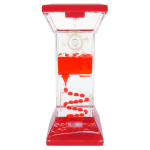Our visual system plays an important role in self regulation. Have you ever felt internally disorganized just by looking at a messy, cluttered room? Or have you sat by a fountain to gaze at the smooth movement of the water and felt a sense of relaxation? Children with sensory processing disorder often need assistance to learn self regulation in order to maintain a steady state of arousal while dealing with the barrage of sensory stimuli present in every day environments. While there are many different avenues to help children with self regulation, it can be difficult to find methods that can be easily carried out in the community without dragging around a suitcase of sensory tools. However, there are some small and portable visual tools that may help a child get through a difficult situation and avoid a complete meltdown before it happens.
_________________________________________________________________________________________
Remember: If your child has a history of seizures, speak with your pediatrician or neurologist BEFORE trying visual tools. Toys with spinning patterns, blinking lights or other visual stimuli may be dangerous for your child to use.
_________________________________________________________________________________________
In general, visual stimuli that are calming in nature involve rhythmic, predictable patterns with steady color or slow color changes. Alerting visual stimuli include bright colors, irregular patterns and flashing lights. It may be helpful to speak with your child’s therapist to decide which type of visual stimuli is appropriate for different situations.
Often the best prices for tools like the ones listed below are outside of the traditional therapy supply companies. Try office supply stores, party stores or websites such as Amazon or www.officeplayground.com. At times, the products from the therapy companies are more durable, but it may take some trial and error to find the right tools for your child. Speak with your child’s therapist for guidance in choosing tools.
Bubbles – A small container of bubbles fits easily into a purse or diaper bag. If your child is able to blow bubbles this may also assist in regulation because of the slow, extended exhalation required.
“Calm Down Bottles” – These homemade bottles are all over Pinterest. Take a clean plastic water bottle and fill it with hot water, clear glue, glitter glue and fine glitter. A detailed recipe with tips can be found here.
Liquid Motion Timers – Although you may not recognize these by name, liquid motion timers are those f un to watch containers with drops of colored oil flowing down a spiral or dripping down a staircase. Some have a liquid ooze that, well, oozes down from section to section. They are mesmerizing. A benefit to these tools is that they are quiet, which may encourage your child to focus and engage just his visual system without the temptation to continue shaking the object and causing alerting auditory input.
un to watch containers with drops of colored oil flowing down a spiral or dripping down a staircase. Some have a liquid ooze that, well, oozes down from section to section. They are mesmerizing. A benefit to these tools is that they are quiet, which may encourage your child to focus and engage just his visual system without the temptation to continue shaking the object and causing alerting auditory input.
Light Up Toys – There are many, many light-up toys available. Some have spinning patterns inside a wand, others have slowly billowing colors along fiber optic strands.
Apps – Mobile devices are often a go-to tool for parents. However, it can be easy to become overwhelmed by the myriad of apps on the market. Here are some calming visual apps we have used in the clinic. Some include sound effects or music while others have no auditory output. The links below are to the Apple iTunes store and are free, but many are available for Android devices as well.


Leave a comment